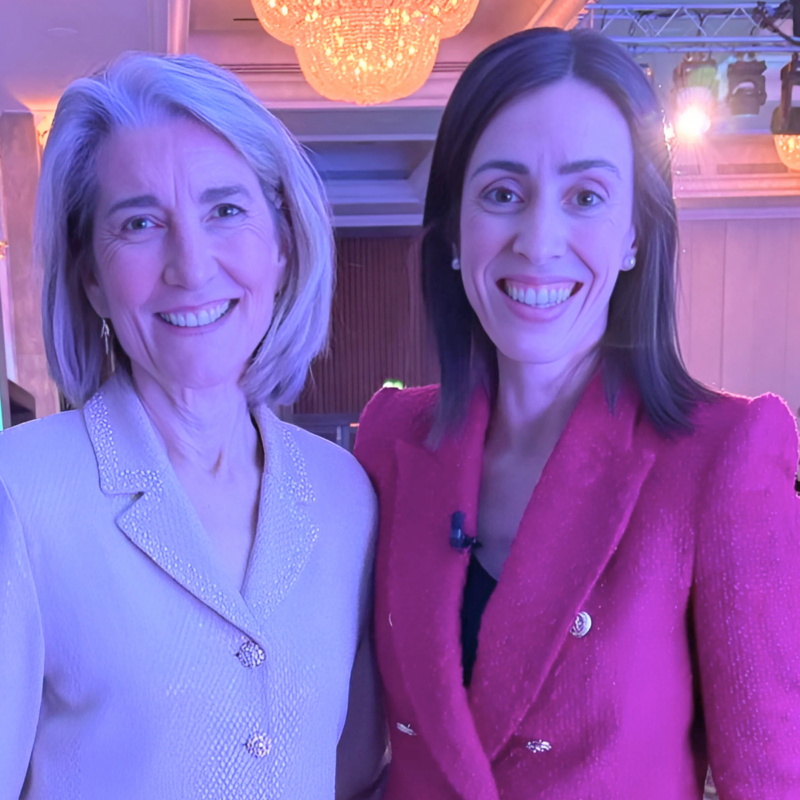Amy Edmondson’s Psychological Safety Principles Every Leader Needs

In a fast-moving, high-stakes world, one factor quietly makes or breaks team performance—and it’s not talent, tech, or tenacity. It’s whether people feel psychologically safe enough to speak up.
A few weeks ago, I had the joy of facilitating the Workhuman Live Forum in London, where Harvard professor Amy Edmondson—pioneer of psychological safety research—delivered a tour de force on the subject. It was funny, practical, and powerful.
She opened with a laugh-out-loud story: flashing back nine years to the Sunday she opened the New York Times and saw Google’s big reveal from their Aristotle Project—their “secret sauce” for high-performing teams. Right at the top #1 spot was… Psychological Safety.
Her reaction? A sinking feeling. Because that “discovery” was her research—from 17 years earlier! Thankfully, Google gave credit where it was due, and Amy’s work was launched into the spotlight where it belongs.
Fast-forward to today, and her message is more relevant than ever. In our chaotic, fast-moving, VUCA world (that’s volatile, uncertain, complex and ambiguous), psychological safety is a business imperative.
Because when people don’t feel safe to ask questions, challenge the status quo, or admit mistakes, your team’s best thinking never gets airtime.

What Psychological Safety Isn’t—and What It Is
Before we go deeper, let’s bust some myths about what psychological safety isn’t:
- It’s not a kumbaya circle where tough feedback gets tossed aside just to keep things nice
- It’s not a comfy bubble where “meh” performance gets a gold star
- It’s not a guarantee that all your ideas will make the cut
As Amy puts it (in that spot-on way she has), psychological safety is simply “a belief that the work environment is safe for interpersonal risk.”
It’s the difference between thinking, “If I speak up, I’ll look like an idiot” and “Around here, asking questions is actually seen as smart.”
A perfect example of psychological safety came from Brené Brown when I interviewed her at PCMA Convening Leaders earlier this year. She shared a story about a young team member who, at the end of a meeting, raised her hand and said she didn’t understand something. It wasn’t just any room. It was Brené Brown’s team. And Brené was in the room.
At the time Brené called it out as what she calls ‘Daring Leadership’, but it also tells you everything you need to know about the culture in that room. That young team member felt safe enough to speak up—and that is psychological safety in real time.
The Silent Killer of Great Ideas in Teams Without Psychological Safety
Ever sat in a room where everyone agreed with an idea only to walk out and spend the afternoon in sidebar conversations about what a terrible decision you’d all just nodded along to?
Right now, in your organisation, brilliant ideas are quietly dying. Not because they weren’t good—but because someone chose to stay silent. Why? Because the perceived risk of speaking up feels bigger than the invisible cost of holding back.
But the data tells a different story.
Amy surveyed 805 senior leaders at a European medical devices company, asking them to reflect on moments when they didn’t speak up. The consequences? Only 7% believed their silence had no impact. The other 93%? Real, measurable negative consequences:
- 5% said it led to a safety issue (which, even in this one group, equates to 40 preventable incidents!).
- A third said time or resources were wasted.
- 20% said their silence contributed to a poor decision.
- Another third said it left them feeling bad or disengaged.
The truth is that silence isn’t neutral—it’s costly. I’ve worked with leadership teams where this dynamic was so entrenched that major strategic decisions would sail through meetings unchallenged, only to be quietly undermined later when implementation failed. The cost? Millions in wasted resources, lost market opportunities, and the slow erosion of trust.
So the question becomes: are you making it safer to speak up than to stay silent? Because unless you’re being intentional about that, silence will win. And so will mediocrity.
The Conversation Equation: Engineering Breakthrough Thinking Through Psychological Safety
At the core of psychological safety is what Amy calls “high-quality conversations”—not the endless meeting marathons you’re sitting through now, but energising exchanges that fuel breakthrough thinking. These powerful discussions don’t happen by accident—they’re deliberately engineered through specific practices and mindsets.
The Four Ways People Show Up (Only Two Actually Help)
Amy’s research reveals a simple but powerful 2×2 matrix that explains why some meetings drain energy while others generate breakthroughs:
- Productive speaking – Dropping insights, asking the non-obvious questions, building on others’ ideas ✓
- Productive silence – Deep listening, processing before speaking, creating space for others ✓
- Unproductive speaking – Interrupting, hijacking, dismissing, going down rabbit holes ✗
- Unproductive silence – Mentally scrolling Instagram, holding back crucial insights out of fear ✗
Here’s the challenge: In any meeting, everyone immediately notices the person dominating the conversation, but it’s nearly impossible to distinguish between someone who’s thoughtfully processing and someone who’s mentally disengaged.
This creates a significant blind spot in our collaboration, where we often:
- Miss out on breakthrough ideas from quieter team members
- Reward quick, confident responses over thoughtful, measured ones
- Allow the loudest voices to drive decisions, regardless of the quality of their input
The High-Performance Conversation Formula
Amy’s research reveals what truly unlocks collective genius:
- Active engagement: Everyone is either meaningfully contributing OR actively listening—with no middle ground and no spectators
- Full presence: The conversation commands complete attention—no side discussions, no devices, no mental checkout
- Balanced dialogue: Maintaining a healthy ratio of statements to questions (too many statements creates an echo chamber; too many questions leads to analysis paralysis)
- Forward momentum: Every conversation visibly advances what matters most to the team and organisation
I’ve personally witnessed this formula transform struggling teams into high-performing units. Meetings shift from energy-draining to energising. Decision quality improves dramatically. And people leave feeling both heard and valued—the foundation of true psychological safety.
The Leadership Imperative: Three Essential Moves
If you’re leading a team, Edmondson’s research offers a clear mandate which she expands on further in her book The Fearless Organisation. Building psychological safety comes down to three critical leadership behaviours:
- Reframe the work as a learning problem. Stop framing challenges as execution problems (“Here’s what needs to happen, go make it so”). Instead, position them as learning opportunities (“Here’s what we need to figure out together, and I don’t have all the answers”). This simple reframe transforms how people engage—from anxious order-takers to motivated co-creators.
- Explicitly invite participation. Don’t assume silence means agreement or that louder voices have better ideas. Create structures that pull diverse perspectives into the conversation. Create deliberate structures that extract diverse perspectives:
- “Let’s hear from someone who hasn’t spoken yet”
- “I want to hear three different viewpoints before we move on”
- “Alex, you look like you might have a different take on this?”
- Respond productively to dissent. Your reaction when someone challenges you is perhaps your most powerful culture-building tool. Your response when challenged is your most powerful culture-building moment. Get defensive? You’ve just taught everyone to keep quiet next time. Get curious? You’ve just signaled that speaking truth is valued.
One question Edmondson suggests leaders ask themselves: “How does it feel when someone points out my error?” Your honest answer reveals volumes about the psychological safety you’re creating.
The S.A.F.E. Framework: Building Psychological Safety in Practice
Drawing from Edmondson’s insights and my own work with leadership teams across industries, I’ve developed a simple framework for building psychological safety in your team. I call it the S.A.F.E. approach:
S – Start with vulnerability
Leadership vulnerability isn’t weakness – it’s strategic strength. When you openly acknowledge uncertainty (“I don’t have all the answers”) or admit mistakes (“I got that wrong”), you create permission for others to do the same. Begin team discussions by modeling the candor you want to see.
A – Ask better questions
Your questions telegraph what you value:
- “What are we missing?” = You value thoroughness
- “Who sees this differently?” = You value diverse thinking
- “What would make this fail?” = You value critical thinking
Questions that invite productive dissent are your most powerful culture-building tools.
F – Focus on learning, not blaming
When something goes wrong (and it will), the conversation that follows determines your team’s future psychological safety. Choose: “What can we learn?” > “Who messed up?” This doesn’t mean avoiding accountability – it means prioritising improvement over punishment.
E – Expect and normalise productive conflict
Innovative teams don’t avoid conflict – they channel it productively. Make healthy debate an expected part of your process rather than an uncomfortable exception. Create explicit norms that distinguish between challenging ideas (encouraged) and challenging people’s value (never acceptable).
The Paradoxical Truth
The ultimate paradox of psychological safety is this: when people feel secure enough to take risks, speak up, and challenge the status quo, they create the exact conditions necessary for breakthrough performance.
In other words, the teams that feel safest take the biggest risks. And in today’s business environment, calculated risk-taking is the only reliable competitive advantage.
So the (potentially multi) million-dollar question becomes:
Are you capturing your team’s full intelligence, or just the fraction they feel safe enough to contribute?
Because as the research conclusively shows, psychological safety isn’t just about making people feel good—it’s about making organisations perform better.
In that equation, everybody wins.
